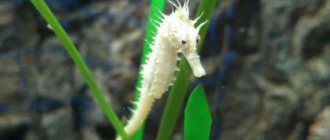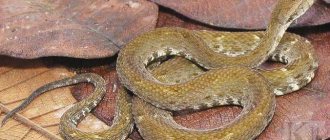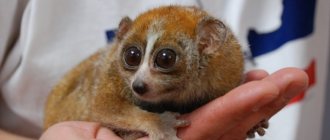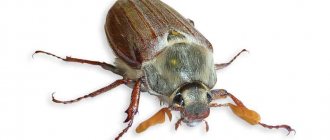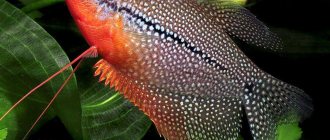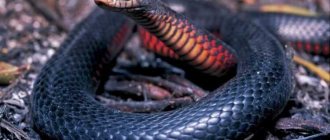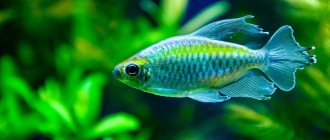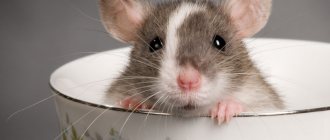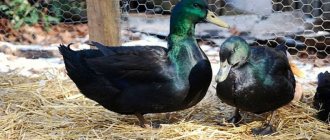Gourami breeding is a very interesting process. These calm fish are considered favorites of aquarists for their relative ease of care and calmness.
As a rule, such fish can be grown and propagated even in a general aquarium, provided that only small, calm fish live in it, and the number of male gourami does not exceed two individuals. This is due to the fact that the fish divide the territory among themselves, which can have a bad effect on the reproduction process.
general characteristics
Gourami are freshwater fish belonging to the suborder of the sliders of the Osphronema family.
These fish differ from others in the presence of an auxiliary respiratory organ - a labyrinth, which is why they are sometimes called labyrinthine. With the help of a labyrinth, fish are able to breathe air. The labyrinth is a transformed first gill arch. At its widest point there are bone plates covered with mucous membrane and blood vessels. According to the mechanism of operation, the organ resembles the lungs. Thanks to it, fish are able to breathe air in conditions of low oxygen content in the water, and they can also live on land for quite a long time.
The labyrinth develops 2-3 weeks after the fry emerge from the eggs. During gourami spawning, eggs should be provided with water that is well saturated with oxygen.
The body of a gourami is long and flat. The anal and upper fins have an elongated and slightly pointed shape. On the abdomen there are thin thread-like antennae, with the help of which the fish can “feel” the bottom. If damaged, the antennae can grow back.
It has been noted that in aquarium conditions, gouramis can grow up to 12 cm, but more often the fish grow from 3 to 8 cm. These are long-lived fish. It was recorded that the age of one of the oldest gourami was 88 years.
Reproduction
It is not difficult to obtain offspring of spotted gouramis. At the age of about 8-9 months they are ready to become parents. They can also reproduce in a community aquarium. But in this case, there is no guarantee that the fry will live for at least a month.
Spawning
- Feeling the need to continue the race, the male spotted gourami immediately begins to build a nest of air bubbles. He attaches it to the leaves of plants floating on the surface. As a rule, the whole process takes him about a day. During this time, he is able to erect an aerial structure with a diameter of up to 25 cm and a height of up to 3 cm.
- Having completed construction, the male begins courtship. If his girlfriend does not show a willingness to spawn immediately, he begins to get angry and pursue her. For such a case, you need to provide several lush bushes in the spawning area so that the female can hide. She will come out to meet the male when she is ready.
If necessary, spawning can be stimulated. To do this, raise the temperature to 28-30 C and change some of the water to a softer one. However, gourami can also take care of issues related to breeding under normal conditions.
The process of throwing eggs is reminiscent of an embrace: the male wraps himself around his girlfriend’s body, curling up in a ring. In fact, there is no place for tenderness in their relationship.
Thus, he only squeezes out the eggs. As soon as a few things are in the water, the father will carefully collect them with his mouth and transfer them to the nest.
Spawning lasts from several hours to four days. During this time, the “hugs” are repeated several times.
As a result, the female produces from 80 to 400 eggs. The amount depends on its size, age and health status.
After making sure that the spawning is over, the young mother can be removed. It is dangerous for her to remain close to the male: he will guard the nest extremely zealously, and is even capable of killing his girlfriend.
In any case, she will not take part in the future fate of the offspring; the father will take on all the worries.
The female is not able to spawn on her own, even if the eggs ripen inside her. If the male is not nearby or he shows indifference to his girlfriend, the eggs will “burn out” and be reborn. After such an experience, females usually become infertile.
Caring for young animals
Within a day, larvae will appear from the eggs. After another 2-3 days they will turn into fry and begin to swim on their own. This will cause a new wave of anxiety in the father, who will try to return the babies to the nest, collecting them with his mouth. In the process, it can damage fragile babies or even kill them. It is better to put him away at this stage.
In the first days of life, the fry are not able to capture air from the surface of the water. The labyrinth organ, which is responsible for this process, will be formed in them only by 2-3 weeks. Before this, the water level in the cage with the fry should not be higher than 5-10 cm. Mechanical saturation of the water with oxygen will also be required.
As the first food for babies, you can offer ciliates and “live dust”. In just a few days they will be ready to try something more substantial. For example, artemia or nematodes.
The fry of spotted gouramis grow very unevenly. Those that increase in size faster eventually begin to eat smaller relatives. You can avoid cannibalism if you periodically sort the juveniles, placing them in different containers according to size.
Types and their description
Let's look at the most popular types of gourami in home aquariums.
Pearl gouramis are one of the most beautiful and widely popular species among aquarists. These fish gained their fame due to their bright red-orange color, they have a dark stripe along their body, and small white dots like pearls adorn their scales.
This fish is also known for making unusual sounds during spawning. The pearl gourami does this with the help of its fins. It is believed that this species has a good memory and is even able to distinguish its owner from other people. The lifespan of pearl gourami is about eight years. The fish can reach 9 cm in length.
The marbled gourami attracts the eye with its color. There is a blue design on the blue body. Light dots are visible on the caudal and anal fins. The body length of the male reaches 10 cm, the female is smaller in size. During the spawning of marbled gourami, the pattern on the body of the male becomes much darker than that of the female.
The body of blue gourami is almost monochromatic, but in some places there are dark spots on the scales. These fish shine beautifully in the light.
Kissing gouramis are famous for their unusual lip shape. When the fish meet and start communicating, it may seem like they are kissing. The body of these fish is colored pink and light green, and the fins are transparent. Kissing gouramis grow large in captivity: up to 15 centimeters, and therefore they need a fairly large aquarium. In nature, they can reach 30 cm, and therefore are quite often eaten. Another feature of this type of fish is its bad character, which makes it difficult for them to find neighbors to live together.
Mr. Tail recommends: variety of species
In the scientific classification, six species of Gourami have been identified, but over the long experience of the aquarium industry in keeping and breeding these fish, many new breeding varieties and breeds have emerged. Here are just a few of them.
Kissing
Helostoma temminkii belongs to the Helostomaceae family. This fish is very popular among aquarists because it has an amazing appearance and unusual behavior.
Ichthyologists discovered this natural variety back in the century before last, but breeders from Florida learned to produce offspring of the Kissing Gourami only in the 50s of the last century.
The variety received its name for its expressive large and clearly defined lips. They are strongly protruded and “ready to be kissed.” In addition, two individuals often connect with their mouths. That is, these fish really kiss, maintaining the hierarchy in the school with the help of tactile contacts.
In nature, they are common in Thailand, Indonesia, Sumatra, Borneo, Java, Cambodia, and in any shallow reservoirs with weak currents and rich plant flora.
The natural color is pale greenish-gray. The dimensions are about 15-17 cm. The structure of the lips is also surprising in that on their inner side there are small teeth, with the help of which the fish scrape algae from any surface.
Pink
The full name of this variety of Helostoma temminkii is Pink Kissing Gourami, as it is not a natural species, but bred from the Kissing Gourami.
In these individuals, unlike the progenitor, the body has a more round shape, but its dimensions are smaller, up to 12-13 cm. The color is pinkish or with an orange tint. The structure of the lips is characteristic - they are large and extended forward, as if in readiness for a kiss.
Pink Gourami are hardy and unpretentious to the conditions, but they are still large for the beginning aquarist, since each fish requires about 100 liters of water. And the character of these pets in adulthood becomes not very peaceful, and their breeding is quite problematic.
Blue
Trichopodus trichopterus are inhabitants of South Asian and Indonesian freshwater areas. This variety of Gourami can be found in slow-flowing rivers of Vietnam, China, Cambodia, Laos, Myanmar, Malaysia, Thailand, the Philippines, Taiwan, Papua New Guinea, the Seychelles, Namibia, and Colombia.
The species has many color isomorphs, some of which have been selectively bred.
The body measures 9-15 cm, it is colored whitish-blue with uneven spots. There is also a brown natural variety.
This omnivorous fish is distinguished by the fact that it eats hydra parasites, which are extremely dangerous for the inhabitants of artificial reservoirs.
All variable varieties of Blue Gourami are closely related to wild ancestors, and therefore are distinguished by excellent health. They reproduce well in captivity.
Lyalius
According to the scientific classification, Trichogaster lalius is also a Gourami, as it has labyrinthine breathing and a similar body structure.
This bright, unpretentious fish grows up to 8-9 cm and is suitable even for beginner aquarists.
Initially they were found only in Asian reservoirs, but are now common in America.
The body and fin plumage are colored in multi-colored stripes from greenish to red and orange.
Schooling fish with a clearly defined hierarchical structure. They reproduce well in home aquariums.
Fiery
Gourami or Lyalius of this variety are bred only artificially. They grow up to 7-9 cm, the body is painted in a bright orange fiery color, the plumage on the back is blue.
A bright and unpretentious fish, suitable for beginners.
Gigantic
Osphronemus goramy is the largest representative of Gourami, growing up to 70 cm in its natural habitat, but in an aquarium it reaches only 40 cm.
The species was originally discovered in South Asian slow-flowing water bodies and was used as a commercial fish by the indigenous population; now it is also found in South America and Australia.
The omnivorous large fish even eats frogs and dead mammals.
As they age, males develop a fatty lump on their forehead. The color is light with dark transverse stripes, but with age they fade and the color becomes monochromatic. The pelvic fins, like all Gourami, are thread-like.
In aquarium farming, artificial coloring of fish using chemical injections is widely used, but this significantly reduces the life expectancy of an individual and is condemned in developed countries.
The fish is schooling, but in an aquarium it lives well in a male-female pair. Males often enter into competition with each other, especially when young.
They breed well in captivity, but a large spawning tank is required.
Red-tailed
Osphronemus laticlavius is also a giant species; even in an aquarium, the length of an adult individual reaches 50 cm. Therefore, for home keeping, a tank of 600-700 liters is required, and ichthyologists practically do not try to breed this variety of Gourami in captivity. Sexual dimorphism is almost completely absent and it is impossible to determine the sex, and it is very difficult to populate a flock of at least five specimens.
But this pet has the most colorful colors. The body color is green-blue, and along the edges of the fin plumage there is a fiery border. With age, all scales and fins may turn red.
It lives in slow-flowing rivers of Asia, Malaysia and Indonesia.
Gold
Trichopodus trichopterus is a selective species bred artificially from the Blue Gourami. The pet grows up to 14-15 cm, has a rich golden color, and is unpretentious and easy to breed. Just like the wild ancestor, there may be dark markings on the body.
Honey
Trichogaster chuna is so named because of its bright, rich coloration in yellow and silver-gray tones. Moreover, it is expressive, although different, in representatives of both sexes, but in the male it becomes even more intense during the mating season.
The fish is small, up to 4-5 cm, schooling, very similar to Lyalius. In an artificial reservoir it behaves very timidly and shyly.
The variety is widespread in the Far East. This fish has a very interesting way of feeding. It spits out a stream of water from its mouth, knocking down insects in flight or from branches, shrubs and trees growing near a pond.
Lunar
Trichogaster microlepis are very beautiful, although their color is dull. The small scales are white, almost transparent, but highly reflective. In low light they glow like moonlight.
They live in the reservoirs of Thailand and are called Pla Kadi Nang by the local population. The last word means "female", as this fish was long considered to be the female Blue Gourami. Also found in Vietnam and Cambodia, in the South American Mekong.
With age, the back of the fish acquires greenish tones, and the iris of the eye turns red. The fin plumage of males has the same shades; in females it is pale.
Neon
Trichogaster lalius is an artificial species bred through selective breeding. This is the most famous modification of Lyalius in the aquarium hobby.
The body of small (7-8 cm) fish has a more rounded shape, thread-like pelvic fins are preserved. The main color is a combination of bright multi-colored transverse stripes from turquoise and blue to burgundy shades.
Marble
Trichopodus trichopterus is a breeding variety of Gourami obtained by crossing Blue.
An adult individual grows up to 12-13 cm, has high fin plumage, colored, like the body, in pale blue tones with sparse dark markings and a small scattering of white spots. The color resembles a marble pattern.
Easily reproduce in home aquariums.
Macropods
Macropodus opercularis is also called Paradise fish and is considered one of the most beautiful aquarium pets. These are inhabitants of reservoirs in Southeast Asia with weak currents; their homeland is Thailand, China, Vietnam, Cambodia, Japan, Malaysia, and Taiwan. The species was brought to Europe in the mid-19th century.
They grow in an artificial reservoir up to 10-11 cm. They are distinguished by pointed fin plumage with a large tail. The color is often bluish, with transverse red stripes.
These are omnivorous and hardy fish, behaving quite aggressively in the aquarium. They reproduce easily, but you should watch especially the male during spawning. The male often, protecting the offspring, even beats the female.
Varieties are also known:
- Black Macropod. It lives mostly in Indonesia. It has an almost charcoal body with red fin plumage.
- Round-tailed. This fish grows to only 7-8 cm, its body is also dark, tinged with green, and there may be a red border on the fin plumage. The tail is rounded and very large.
Pearl
Trichopodus leerii is the most peaceful of all Gourami species, growing up to 10-12 cm in length.
They got their name from their original coloring. The main background is light brownish or reddish, with small specks of pearls scattered across it. A patterned border extends along the back to the tail.
The species was discovered in the century before last in Asia. Lives in bodies of water with slow currents in Thailand, Malaysia, Borneo, Sumatra.
The natural population has now greatly decreased, but mass production of fish for the aquarium hobby operates in Europe and the Far East.
They reproduce easily in home tanks.
Platinum
Trichopodus trichopterus is a selected species of Blue Gourami that does not live in natural conditions, although the aquarium variety is unpretentious and hardy.
Pets grow up to 12-13 cm. They are similar to the wild ancestor, but the main background is snowy with a yellowish and silvery tint. The back, belly, and fin plumage are more heavily tinted, with dark markings remaining at the tail and along the midline.
Snakes
Trichopodus pectoralis is a large natural species (15-20 cm) that lives in south-eastern natural reservoirs with weak currents. Distributed in Cambodia, Vietnam, Malaysia, Philippines, Indonesia.
The name is determined by the remarkable color in yellowish and brown tones, patterns reminiscent of snake skin.
Thick lips
Trichogaster labiosa or Labios is a small fish (about 9-10 cm) slightly reminiscent of the Golden Gourami in color.
At first, this species lived only in Asia, but already in the 19th century it was distributed throughout South American waters. The main color is orange or yellowish-brown, males with vertical turquoise stripes. Females are paler and the lines of the pattern are almost invisible.
Peaceful appearance, easy to breed.
Grumpy
Trichopsis vittata - small Gouramis (6-7 cm), living in slow-flowing reservoirs of Vietnam, Laos, Cambodia, Thailand, Malaysia, Indonesia, were also brought to America.
The main background of the body is grayish or brown, there are black longitudinal lines. Males have purple plumage with burgundy markers.
Dwarf
Trichopsis pumila is often called Pumils. This is a small fish (3-4 cm), which is very unpretentious and easily reproduces in captivity.
This variety of Gourami originated from Asia and lives in the rivers of Vietnam and Thailand, Cambodia and Malaysia.
The body is pale brownish with a bluish tint, with two longitudinal black stripes. The plumage is patterned with red and blue dots. It is very difficult to distinguish a male from a female; the male has a slightly brighter color and larger fins.
Thoughtful
Ctenops nobilis or Ctenops are very unpretentious in aquarium keeping and grow up to 9-10 cm.
They live in the Indian rivers Ganges and Brahmaputra, and are also found in Nepal, Bhutan and Bangladesh.
A very warlike appearance with a patterned body in brownish and silvery tones with individual markings. Males are distinguished by red edging on their fins.
Capanuses Dei
Pseudosphromenus dayi is a very calm and peaceful species of Gourami, growing to only 5-6 cm.
In nature, they live in Indian reservoirs, mostly in the foothills of the Western Ghats.
The main background of the body is reddish-brownish, there are longitudinal dark stripes. There is a bluish line along the edge of the fin plumage. Females are paler.
Parosfromenus
This type of Gourami has several varieties. Among them:
- Dark. Parosphromenus nagyi grow to only 3-4 cm, but are very difficult to breed. Endemic to the Malaysian east coast. Males are very bright and warlike. The main background is brownish with two stripes along the entire body. When excited, males turn almost orange and their fin plumage is charcoal with neon bluish markers. Females are much paler.
- Deissner. Parosphromenus deissneri is an endemic species of Bangka Island (Indonesia). Grows up to 4-5 cm. Longitudinal alternating wide stripes of black and yellow colors run along the body. The fin plumage is also colored, but has blue markers. Males become even brighter during spawning. Females are paler.
Labioses
Trichogaster labiosa is a very peaceful variety of Gourami. Natural habitat: Southern Myanmar. In aquarium conditions it grows up to 9-10 cm. Males are slightly larger and brighter colored than females, in blue and orange tones with oblique dark stripes.
Striped
Trichogaster fasciata is also called Coliseum Striped, Lamellar Goura.
They are very simple and unpretentious to keep, easy to reproduce, and suitable for beginner aquarists. They grow up to 8-10 cm and can be kept either in a group or alone.
They are brightly colored in orange and blue colors with stripes and speckles. Females are smaller and paler.
Chocolate
Sphaerichthys osphromenoides grow up to 4-5 cm and are a surprisingly peaceful species of Gourami.
This species has very strong parental instincts, and the main role in breeding offspring in a pair is given to the mother, although usually in labyrinth fish this role is taken by the male.
The homeland of the species is Southeast Asia, Hindustan, Maklaka Peninsula.
The main background of the body is brownish, with transverse stripes of lighter colors located on it. There may be red markers on the plumage (this depends on the habitat of the fish).
False chocolate
Parasphaerichthys lineatus is a very small fish (2 cm), quite pale in color and not very easy to keep and reproduce.
In nature, it mainly lives in slow-moving reservoirs of Myanmar.
The body is quite tall, the male becomes orange in color when excited, and much paler when calm and does not look too much like a true Chocolate Gourami.
Giant chocolate ones
Sphaerichthys acrostoma reach a length of about 7-8 cm in adulthood, their colors are not too bright, and they are not easy to keep.
In nature, they are most found in the rivers of Borneo.
The body is long and narrow, the head is pointed. The background is grayish, the plumage is translucent, the pattern is pale. During spawning, males develop a longitudinal dark stripe.
Belothonia
These fish come in different types. The most common:
- Belothonia Signata. Belontia signata is often called the Sri Lankan Fighting Fish due to its combative nature. Body length reaches 12-13 cm. Endemic species of Sri Lanka. The main background is ruby to ocher in color, the plumage on the tail is uneven and jagged.
- Belothonia Haselda. Belontia hasselti reaches 20 cm in length and has a very unfriendly temper. The homeland of the species is the Greater Sunda Islands, Malaysia, Thailand. The main background of the body is snow-milky with a honeycomb mesh pattern, which becomes very bright during the mating season.
Fish-Crawlers
Anabas testudineus or Anabas, like all labyrinthine species, belongs to the collective name Gourami. The fish is native to Asia, but is now found in both Australian and American waters.
This species is hardy and resilient; it can move on land on pectoral fins and gill covers, using its tail for propulsion.
The coloring of the Pineapple is inconspicuous; in its homeland, the fish is used in fishing.
Individuals grow up to 20-30 cm, with females being larger. The main background is grayish or brownish, there are dark markings, the fins and tail are rounded.
Chameleon Fish
Badis badis are able to change colors and are easy to maintain.
The homeland of the species is Southeast Asia, India, Pakistan, Nepal, Bangladesh, Myanmar, Thailand. They grow up to 5-6 cm, the color is variable - from orange to blue or purple. The color depends on the conditions of the aquatic environment. Males are larger and brighter.
Ctenopomas
Several types of them are known:
- Eight-lane. Microctenopoma fasciolatum is an African variety of Gourami, grows up to 8-9 cm. The main background color is gray or dark brown, it has transverse uneven dark stripes, plumage with a bluish tint.
- Leopard print. Ctenopoma acutirostre also lives in Africa. The color is spotted in brownish tones. The body is high, the fins are jagged. They grow up to 18-20 cm. It is more of a predator, considered conditionally peaceful.
- Sophisticated. Ctenopoma acutirostre is also called Ctenopoma Ansorg. This is a small (6-7 cm) and fairly calm fish, living mostly in the Congo River basin. Males are brighter than females; the pattern consists of transverse wide stripes of gray and orange, which continues on the fin plumage.
Leaf Pisces
Monocirrhus polyacanthus can take the form of leaves that have fallen to the bottom of a reservoir, so they camouflage themselves from predators and while hunting their victims. This is a difficult species to keep and reproduce, distinguished by its interesting appearance and habits.
The homeland of the variety is South America (Brazil, Peru, Venezuela, Colombia, Bolivia).
They grow up to 10 cm. It is better to keep these pets alone or in mixed-sex pairs. The body is narrow, yellowish-brownish, resembling the color of a dried tree leaf. Predators, quite aggressive, feed only on live food during the hunt.
Crestsera paradise fish
Malpulutta kretseri or Malpulutta is named after the Frenchman De Cresset, who was a lawyer, but was passionate about ichthyology.
It is endemic to Sri Lanka and has virtually disappeared from its natural range, but is widely bred in captivity.
Adults grow to only 3-5 cm and are easy to keep and reproduce.
Males are larger and brighter than females. The color is grayish-yellowish speckled with a dark shade. The plumage has a bluish tint and a richer edging.
Ocelathus
Parasphaerichthys ocellatus is also called Ocellated Parasphaerichthys, Dwarf or Burmese Chocolate Goura. A very easy to maintain and reproduce peaceful species, growing only 2-3 cm. They live naturally in Myanmar, throughout the Irrawaddy River basin. They can be kept in an aquarium either singly or in pairs or in a flock.
A related species to the Chocolate Gourami, similar in color but lacking the filiform pelvic fins. The head is large, all plumage is short. In the middle of the body there is a black spot with a golden edge. Females are slightly larger than males, but paler.
Gourami Selatana
Sphaerichthys selatanensis also has another name - Cross Chocolate Gourami. The main background is grayish-brownish, and the pattern is of crosses composed of longitudinal and transverse dark stripes. The body length of adult individuals is about 4-5 cm; in male specimens, unlike females, the lower part of the head is only slightly rounded.
They live in slow-moving ponds of Kalimastan, in the Indonesian province of Selatan, from which they got their name.
Gourami Vaillanta
Sphaerichthys vaillanti is a small fish (4-5 cm) with a peaceful nature and easy to keep. They originate from the western regions of Borneo, but almost the entire natural population has been exterminated.
The body of the fish is high, the head is pointed, the fins on the back and abdomen are long, stretching throughout the body. The color combines red and green colors. Unlike other varieties of Gourami, females become especially bright during the mating season.
Males are pale, grayish-brown, with a pouch of skin under the lower jaw.
Schaller's gourami
Trichopsis Schaller is named after the famous fish exporter Dietrich Schaller, who was the first to bring these individuals to the European market.
Schallers grow up to 4-6 cm, are distinguished by their ability to make peculiar sounds and have a difficult character during the mating season. The rest of the time they behave quite calmly.
In nature, they mostly live in the Mekong River basin in Laos, Thailand, China, Vietnam, and Cambodia.
The color depends on the habitat, it can be blue or yellow. Males are larger and brighter.
First appearance in aquariums
For a long time, gourami could not be taken out of their habitat for the purpose of distribution in aquariums. Several times they tried to transport the fish in barrels filled to the brim with water. Not a single fish survived the move. It has long been believed that these fish are unsuitable for transportation.
Everything changed at the end of the 19th century. One of the scientists noted that in nature these fish periodically emerge from the water to swallow some air. He suggested not filling the barrel with water to the brim. As a result, they tried to transport the fish in a barrel two-thirds filled with water. In 1896, for the first time, it was possible to successfully transport gourami, and not a single fish died. Soon, gouramis, as easy-to-keep and easy-to-breed fish, became widespread in aquariums all over the world.
Pearl gourami care and maintenance
Aquarium.
To keep this species, you must have an aquarium with a capacity of more than 50 liters. This volume is enough for 6–7 pieces (for 1 male you need 2–3 females). If the aquarium has a lid, it should not fit tightly as air needs to be constantly circulated. For a layer of soil (5–6 cm), take coarse river sand, the structure of which is suitable for algae growing in the aquarium.
Vegetation.
These small fish like to hide and build their nests in thickets, so lush, bushy vegetation is suitable for keeping them: elodea, vallisneria, pinnate.
Don't use too many plantings, give them room to float.
You can spread duckweed on the surface, collecting it into islands. Just watch out for its growth: it should not cover the entire surface of the water so that the fish have access to air.
Water parameters.
Gourami love warmth, so be attentive to the temperature of their habitat. It should be 24–27°C, otherwise the fish may get sick. It is best if the aquarium is equipped with a heater with a thermostat. Try to change the water regularly (25% of the aquarium volume per week).
Compatibility.
Keeping them with other species can be problematic. But the point is not in the character of gourami; they cannot be called fighting ones. The point is the neighbors, who may be attracted by their worm-like fins. If you still want to add other fish to them, find out if they are aggressive or predatory, otherwise the gouramis will not get along with them. Such unwanted neighbors include swordtails, barbs, some species of cichlids and characins.
GURAMI CARE CONTENTS DESCRIPTION SPAWNING COMPATIBILITY.
Natural habitats
Gourami got its distribution from Southeast Asia and the adjacent islands. The first aquarium fish were caught in Vietnam, Malaysia and Thailand. Different types of gourami live in different areas.
In nature, they live in standing and flowing reservoirs of various sizes. Brown and spotted gouramis live in brackish estuaries and tidal zones.
Nowadays, some species of gourami are listed in the Red Book, while others are completely bred in aquariums and are not found in nature.
Other forms
Spotted gouramis by nature have a rather restrained color: on the gray-blue body there are two modest decorations - dark spots on the sides. With the help of geneticists, handsome men with a much brighter appearance appeared in their family. The most common forms were:
A golden gourami whose body is painted in a color reminiscent of precious metal. Dark spots on the back only add charm;
A blue gourami that has received a heavenly body color and inherited from a spotted ancestor - two dark marks on the sides;
The marbled gourami has a complex silver-blue body color with a large number of dark “freckles”. As a result of selection, such fish were able to grow a little: in an aquarium they grow up to 15 cm.
In the reservoirs of Indonesia and Malaysia lives a “true gourami” (Goramy), which can grow up to a meter in length. Locals call it water boar and value it very much. But not for beauty, but for its amazing taste and nutritional properties. When smoked, this gourami is incomparable.
Feeding
Gourami fish are unpretentious in terms of feeding. They can be given dry, live and artificial food. The basis of the diet should consist of artificial flakes and granules. You can supplement the diet with frozen and live food: bloodworms, crustaceans, insects, dry and live daphnia, and tubifex.
These fish have a small mouth, so it is advisable to grind the food before feeding. Adult gourami can withstand a hunger strike for 7-14 days, so they can be safely left without food during the holidays.
Raising gourami fry
After spawning, it is better to immediately remove the female, otherwise the angry father, protecting his nest and offspring, may take out his aggression on her. The male gourami actually raises the fry. The eggs stay well in the foam nest, but if they suddenly go to the bottom, the male immediately reacts and returns them back. After a day or two, the fry hatch. The incubation time depends on the water temperature, which must be constantly monitored: if the male senses something is wrong, he can stop caring for the fry and destroy them. Also during this period he is not given any food. The father is left in the aquarium until the offspring learns to calmly swim around the aquarium. The hungry dad “moves” back to the common aquarium, the nest begins to collapse without him, but the little gouramis no longer need it. Gourami fry should be fed ciliates and zooplankton.
Reproduction of pearl gourami, one of the most beautiful species, is a little more complicated. During the spawning period, it is recommended to be very sensitive to what is happening in the spawning area and under no circumstances disturb the fish.
Reproduction of other varieties - marbled, blue, honey, etc. gourami follows the same scenario.
PEARL GURAMI Characteristics of external features
This fish has a fairly tall body; the shape of the pearl gourami is flatter in the lateral area and extends in length. The body of the fish has a magnificent silver-violet color, various pearlescent spots are located throughout the body and fin area, and a dark stripe stretches along the body. The name of this fish is due to the presence of spots, since they closely resemble pearls. The length of the fish is eleven centimeters. Female pearl gourami are smaller in size than males and have a light coloration. Compared to females, males have a more elongated dorsal and anal fin. The chest and abdomen of males have a bright red-red color during the spawning process.
PEARL GURAMI Habitat Features
Pearl gouramis have unique beauty ; they have a peaceful and quiet temperament, but the fish are quite shy. They live comfortably in an aquarium with fish of various species and calm in nature. Providing comfortable living conditions for these fish is quite simple, since they are unpretentious. A convenient aquarium for pearl gourami will be a reservoir of 40 liters or more in volume, filled with many plants and all kinds of shelters that the fish need so much. Dark soil will also be most pleasant for them. Do not forget to leave free space for the fish in the aquarium where they can swim, and it is also important to maintain clean water and natural light. For these fish, the following water parameters are comfortable: temperature in the range from 23 to 27 degrees, hardness no more than 16°, and pH 6.0-7.0. Once a week, the water should be filtered and aerated, and at least 30% replaced. Bloodworms, tubifex, daphnia, that is, live food, are suitable food for pearl gourami; however, dry food is also suitable for feeding fish.
Content Rules
Gouramis are happy timid fish, so the soil must be densely populated with algae so that the fish can hide in it. The optimal temperature for fish is 24-28 degrees. It is important that the water and air temperatures are the same. If the air temperature is much lower, the fish may freeze its breathing apparatus. Acidity pH - from 6.5 to 8.5.
To achieve the most vibrant color, it is necessary to create bright lighting in relatively dark soil.
Gourami do not need highly oxygenated water. However, it is still advisable to install an aerator. Its power should not be made large so as not to create currents, because gourami in nature usually live in stagnant water.
The fish must have access to air, and therefore you should not plant the aquarium with a large amount of swimming algae. However, they are necessary so that the male can create a nest during spawning.
Gourami need space to play and swim. Gourami can be kept in small flocks. There should be three females for every male. An aquarium with a volume of one hundred liters should be enough for six individuals.
These fish are capable of jumping high, so a lid for the aquarium is necessary. However, labyrinth fish breathe air from the surface, which means there must be good ventilation under the lid. The distance between the lid and the water should be at least 5 cm.
What to feed the fry
The fry do not need food for another 3–4 days, feeding on the contents of the yolk sac. They will then require external feeding. Meals can be provided 5-6 times a day, the portions should be small.
Food for gourami fry can be as follows:
- Rotifer.
- Ciliates.
- Liquid food for fry.
- Hard-boiled egg yolk, pureed through cheesecloth.
After just a few weeks, the fish can be transplanted into a common aquarium, while adding protein-rich food to their diet - it will help the scales develop correctly and add brightness to the color.
Sex differences
Gourami have clearly expressed sexual dimorphism, so even an amateur can distinguish a male from a female. Females have shorter fins and have a rounded shape. They have a round and wide body. In males, the fins are pointed, and the upper fin can reach the length of the tail. Males have a larger body than females. It has an elongated, pointed shape. Males are much brighter than females.
During spawning, gourami males become much brighter in order to attract the attention of the opposite sex, while females remain dull and inconspicuous.
Compatibility
Usually Gouramis behave quite peacefully, especially when kept in schools. But when excited or during spawning, males can be somewhat aggressive, so it is better to keep one male and several females.
In addition, many underwater inhabitants hunt for the labyrinthine pets themselves with their thread-like ventral fins and can pinch them off.
Gourami get along well with pets that are as active and timid as they are:
- Sumatran barbs;
- small cichlids;
- cockerels;
- parrot fish;
- astronotuses;
- corridors;
- pleskostomus;
- scalars;
- mollies;
- platies;
- iris;
- rasborami;
- labeo;
- goldfish.
You should not add too large and aggressive underwater inhabitants to labyrinth fish:
- large cichlids;
- large barbs;
- swordtails.
It is better to house Gouramis that are too pugnacious, for example Macropods, alone.
Labyrinthine predatory fish are often used to combat the overgrown population of hydras and snails, as this is Gourami’s favorite delicacy.
Setting up the spawning tank
It is not difficult to spawn gourami at home. As a spawning tank, you should choose an aquarium with an approximate volume of 40-80 liters, filled with 15 cm of water. The small size of the aquarium and low water level usually have a positive effect on gourami reproduction, but there are exceptions. There are species that require a fairly large spawning tank: kissing, blue, pearl gourami, and species in which the adult size reaches more than 25 cm.
Most gourami species create foam nests in the leaves of waterfowl. For other species it is necessary to provide shelters.
The filter should not be very powerful so as not to damage the eggs.
How to distinguish a female from a male
To select fish for breeding, it is important to be able to distinguish the different sexes from each other.
You can determine gender by appearance:
- Boys are different in that they are larger and more active. Females are slightly smaller, their body is dense, and the tummy of mature individuals becomes rounded.
- The female is also distinguished from the male by the type of dorsal fin. She has a rounded shape, while in males it is pointed.
- There are also differences in color: males are bright, females are duller. Before spawning, pigmentation intensifies, and males become even more recognizable - this helps determine the sex of gourami with high accuracy.
Breeding
A photo of gourami spawning is presented below.
First, the male is transplanted into the spawning tank. It is necessary to gradually raise the temperature to 29 degrees. The male begins to build a foam nest in the thick of floating algae.
Afterwards, a female with a rounded abdomen full of eggs is placed in the spawning tank. A skinny female, not ready for reproduction, can be driven to death by the male. If the female is ready to breed, the male begins to court her. It changes a lot in color - it becomes much brighter.
Gourami spawning in an aquarium is a truly unusual and interesting sight. The male invites the female to the nest, and there, clasping the female with his body, he turns her over with her belly towards the nest. The male squeezes the female tightly, squeezing out the eggs and fertilizing them at the same time. Afterwards the male releases the female. He collects the eggs in his mouth, and then places them in a foam nest. The process is repeated several times.
When the female is completely drained, the male becomes aggressive and continues to pester her. The spawning ground must have algae in the water column, in which the female can hide from the male. Since the male jealously guards the nest, after the gourami spawns, the female must be removed. Otherwise, the male will strongly pluck the female and chase her away.
When does puberty occur?
Representatives of the species reach full sexual maturity at approximately 8–12 months of age. It will not be possible to get offspring earlier.
When favorable conditions are created, the female is capable of spawning approximately 4–5 times per season. Between each birth of offspring, a break of several weeks is required.
It is important that gourami have the opportunity to rest and fully recover after having offspring.
Caring for fry
The male takes care of the eggs and valiantly performs his duties. If an egg falls out of the foam, he carefully returns it to its place. After two days, larvae emerge from the eggs. It will take another three days for the larvae to become fry. During this period, it is important to monitor the water temperature, because if it decreases, the male may well destroy the nest and eat the larvae.
While the fry cannot swim on their own, the male monitors them and helps them swim to the surface. After the babies learn to swim on their own, the male can be returned to the community aquarium. It is very important not to miss the right moment, since the fry, spreading in different directions, which no longer need their father’s care, irritate the male so much that he may well eat them.
The fry can be initially fed with ciliates and later slowly switched to zooplankton. If the fry grow at different rates, it is advisable to remove larger individuals so that they do not eat small fish.
Thus, gouramis are very beautiful and easy to keep fish. They are unpretentious in food, and even a beginner can reproduce them. This is why these aquarium fish are so popular in home aquariums.
Reviews of gourami
Arthur, review of the dwarf gourami
Yes, the guys are very serious and businesslike, not a single centimeter of the aquarium will be left without their attention. Each bush is examined in a measured and planned manner. Calmly feed the catfish (2 times more) for food. They constantly sort things out (but without fighting, just chatter). I spawn often. They are very beautiful, they sparkle, they also turn red during spawning, and when they feel bad, they turn pale to colorlessness. Relatively unpretentious. They love the lingering surface of the water. Hunters. Predatory roots make themselves felt. And if small fish may not be touched (but bagged for testing or just for fun), then shrimp will be used as expensive food. Even adult amankas. And the smaller the aquarium, the higher the probability. I don’t recommend more than 5 pieces in small quantities. They look better in a flock. The ideal is 15 sparkles in 60 liters full of thickets.
Maria, review of marbled gourami
I really love my pair of gourami (the guy is red and the girl is deep blue), very friendly, always in sight, they don’t offend other fish, they don’t dig up the soil, a real decoration for a tropical aquarium with an abundance of plants! True, my male chose the blue one from the two females offered to him, but killed the red one, so I had to give her back to the store! Love is a complicated matter)))
Nuuk, review of pearl gourami
Stunningly beautiful sociable fish. Non-aggressive, they drive away other fish even during spawning without consequences for their health. They live happily together with cherry shrimp; the shrimp population practically does not suffer. They get along well with flocks of Corydoras. They do not spoil the plants. With good care they live quite a long time - 5-7 years.
Disadvantages: They can bite off the mustache and eyes of ampullaria. Just out of a desire to enjoy. Fishes are quite thoughtful. Aggressive small neighbors, such as neons and barbs, can offend them - bite their fins, snatch food from under their noses. However, this is not a drawback, but rather a feature. They are picky about water quality and temperature. If feeding is improper, water parameters are unstable, or it is polluted, they easily become ill. Susceptible to hexamitosis (hole disease). Carefully inspect the pearl gourams you purchase so as not to buy sick fish.
In childhood, these fish are not very impressive, but when they grow up, they are something! Especially the males: the belly is red-orange, like a carrot, the silvery spots shimmer, and the fins are long and lacy. No photograph can convey this. The fish are very curious; they try to touch people with their whiskers through the glass. They need a varied diet. There are no difficulties in keeping for an experienced aquarist, but for the first aquarium in your life it is better to take simpler fish. The fish is large, I think that 45 liters of useful volume per steam is the minimum. In a smaller aquarium the fish will suffer.
Preparing the spawner
As a spawning tank, it is better to take an aquarium with a volume of 30 liters. There should be shelter for the female, personally I use ceramic driftwood; floating plants - for me it’s usually pistia, you can add a few branches of nayas or hornwort. We put a heater in the spawning tank - the temperature should be about 25 degrees. The water in the spawning area can be softened, which will serve as a stimulus for spawning. Water should be poured into the spawning tank at the rate of 50% water from the aquarium and 50% water from fresh, settled water.
